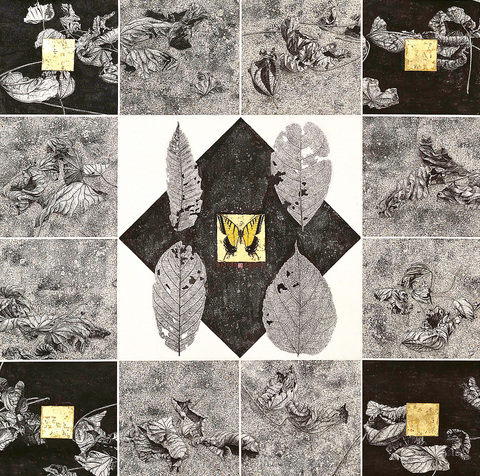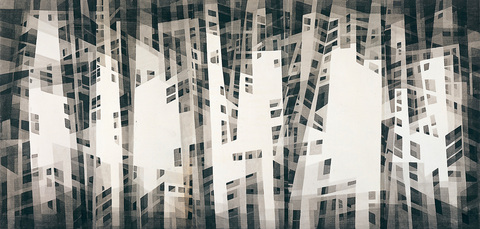As we are all excitedly awaiting the grand-opening next month of the newly refurbished National Palace Museum, which promises to be well worth the wait, there is another exhibition currently on view to satisfy our fix for Chinese-style art. Ink Transformation: Modern Ink Painting in Taiwan at the Taipei Fine Arts Museum provides a short history lesson for Chinese ink painting created in Taiwan from the mid-20th century to the present.
The Museum wants to show that the genre of Chinese ink painting is not staid, nor conventional, but can encompass today's world concerns. The works are installed on neutral gray walls which allow for the brilliance of the colored inks to shine forth.
The first work in the show is Yu Cheng-yao's (余承堯) Yangtze River, a large screen rolled out on a table that shows a multi-perspective god-like panoramic view of the great river. Nature dominates, and even though this was painted in 1973, it does not depict any environmental destruction or pollution, but presents an overwhelming pastoral scene that seems to belong to another era.

PHOTO COURTESY OF TFAM
More experimental landscapes can be seen such as Chen Chi-kuan's (陳其寬) 2002 Xanadu with its overall patterning of black and gray blobs that "read" as mountains.
Some ink painting done in the 1990s looks like it could have been done by the New York Abstract Expressionist painters of the mid-20th century, making the viewer think about the continuity of art history and concepts of originality. Chu Ko's (楚戈) Mountains and Ravines painted with its 20cm-wide brush gives the sense of urgency with its quick-painted movements.
More conceptual paintings are on view. Li Yuan-chia (李元佳) Work III on rice paper, a series of small finely rendered ink circles that appear as a sort of a Morse code, but the care with which it was painted seems to symbolize that each drawn circle is not a mere dot, but epitomizes the whole of existence.

PHOTO COURTESY OF TFAM
Some works go flying off the scroll. Chen Mei-chen's (陳玫蓁) Floating By 2003 ink-painted cut-out fragments in the shapes of clouds are installed behind 3D lattice-strip frames. Wu Chi-tao's (吳繼濤) Romantic-style painting Restlessness gives the sense of the infinite as the tree tops swirl and birds fly up to the sun; it is as if you could hear the mad flutter of wings, while being dazzled by the streaming rays of sunlight.
Pan Hsin-hua's (潘信華) One Day at first glance seems to be a traditional-style scroll painting until the signs from the modern world encroach, such as corporate logos and brand names. Lien Jui-fen (連瑞芬) exhibits a grid of 20 small framed paintings of landscapes that play with scale so that the ambiguous imagery could be a microscopic scene or a vast landscape.
Lin Ju (林鉅), who is known for his macabre paintings, exhibits an ink painting done in 1999 that shows his mastery of drawing. The piece causes some conflict in the viewer, as the quality of drawing is to be gently savored, but the garishness of the headless torsos and lashing tongues out of a body's orifices can be repulsive to some.
To show that ink painting is not confined to its ivory tower, there is Yuan Chin-ta's (袁金塔) installation of a squat toilet bowl with rolls of toilet paper containing calligraphic texts. This may seem to debase the genre, but is more likely an indictment of the cultural institution.
Yuan Zhan (袁旃), who gained international recognition for her participation in the Istanbul Biennial 2001, is represented by her multicolored landscapes that simultaneously look traditional and futuristic. Overall, the exhibition shows the strides made in ink painting over the past 50 years, but also inadvertently asks whether this is a medium that can continue into the 21st century.

In the March 9 edition of the Taipei Times a piece by Ninon Godefroy ran with the headine “The quiet, gentle rhythm of Taiwan.” It started with the line “Taiwan is a small, humble place. There is no Eiffel Tower, no pyramids — no singular attraction that draws the world’s attention.” I laughed out loud at that. This was out of no disrespect for the author or the piece, which made some interesting analogies and good points about how both Din Tai Fung’s and Taiwan Semiconductor Manufacturing Co’s (TSMC, 台積電) meticulous attention to detail and quality are not quite up to

Chinese Nationalist Party (KMT) Chairman Eric Chu (朱立倫) hatched a bold plan to charge forward and seize the initiative when he held a protest in front of the Taipei City Prosecutors’ Office. Though risky, because illegal, its success would help tackle at least six problems facing both himself and the KMT. What he did not see coming was Taipei Mayor Chiang Wan-an (將萬安) tripping him up out of the gate. In spite of Chu being the most consequential and successful KMT chairman since the early 2010s — arguably saving the party from financial ruin and restoring its electoral viability —

It is one of the more remarkable facts of Taiwan history that it was never occupied or claimed by any of the numerous kingdoms of southern China — Han or otherwise — that lay just across the water from it. None of their brilliant ministers ever discovered that Taiwan was a “core interest” of the state whose annexation was “inevitable.” As Paul Kua notes in an excellent monograph laying out how the Portuguese gave Taiwan the name “Formosa,” the first Europeans to express an interest in occupying Taiwan were the Spanish. Tonio Andrade in his seminal work, How Taiwan Became Chinese,

Toward the outside edge of Taichung City, in Wufeng District (霧峰去), sits a sprawling collection of single-story buildings with tiled roofs belonging to the Wufeng Lin (霧峰林家) family, who rose to prominence through success in military, commercial, and artistic endeavors in the 19th century. Most of these buildings have brick walls and tiled roofs in the traditional reddish-brown color, but in the middle is one incongruous property with bright white walls and a black tiled roof: Yipu Garden (頤圃). Purists may scoff at the Japanese-style exterior and its radical departure from the Fujianese architectural style of the surrounding buildings. However, the property